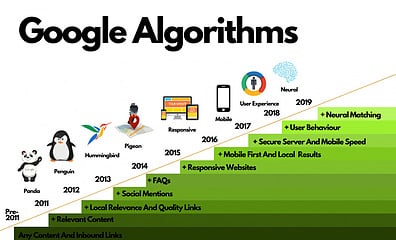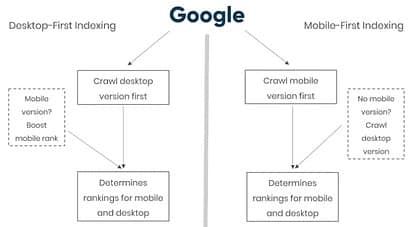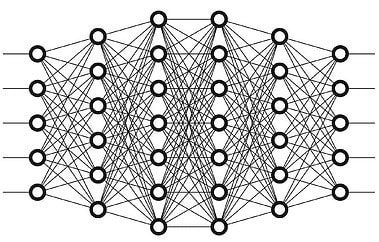 In the ever-evolving world of search engine optimization (SEO), understanding the significance of Google algorithm evolution is crucial for any digital marketer or website owner. Google’s algorithms play a pivotal role in determining the ranking of websites in search engine results pages (SERPs). As SEO strategies constantly adapt to these algorithm updates, it is essential to stay informed about the latest changes and their implications on your website’s visibility and organic traffic.
In the ever-evolving world of search engine optimization (SEO), understanding the significance of Google algorithm evolution is crucial for any digital marketer or website owner. Google’s algorithms play a pivotal role in determining the ranking of websites in search engine results pages (SERPs). As SEO strategies constantly adapt to these algorithm updates, it is essential to stay informed about the latest changes and their implications on your website’s visibility and organic traffic.
The Origins of Google Algorithm
In order to understand the present state of Google’s algorithm, it is crucial to delve into its origins and explore the early days of its development. One of the key components that laid the foundation for Google’s algorithm is the PageRank algorithm.
PageRank revolutionized search engine optimization by introducing a new approach to ranking web pages based on their relevance and authority as follows;
- It relied heavily on backlinks, considering them as votes from other websites vouching for a page’s credibility and importance.
- Keyword density played a significant role in determining a page’s relevance to a particular search query. Websites strategically optimized their content by including relevant keywords in their text, headers, and meta tags.
- Meta tags were particularly important as they provided additional information about a webpage’s content to search engines. By optimizing meta tags with relevant keywords and descriptions, website owners aimed to improve their visibility in search results.
While backlinks, keyword density, and meta tags were once primary factors in determining rankings, Google has since evolved its algorithms significantly. Today, numerous other factors contribute to ranking decisions such as user experience signals and semantic analysis.
Understanding the origins of Google’s algorithm sheds light on the evolution of SEO practices. By exploring the early days of Google’s algorithm development, we gain valuable insights into how SEO strategies have evolved over time and how we can adapt our approaches accordingly.
Role of Google Algorithm Updates in SEO
 Google algorithm udates are designed to improve user experience by delivering more relevant and high-quality content. By analyzing various factors such as keywords, backlinks, user engagement, and mobile-friendliness, these algorithms determine how websites are ranked.
Google algorithm udates are designed to improve user experience by delivering more relevant and high-quality content. By analyzing various factors such as keywords, backlinks, user engagement, and mobile-friendliness, these algorithms determine how websites are ranked.
Keeping up with these updates allows you to align your SEO efforts with Google’s ranking factors, ensuring that your website remains competitive in search results.
Understanding the significance of Google algorithm evolution empowers you to make informed decisions when it comes to optimizing your website. By staying updated on algorithm changes and their impact on SEO practices, you can proactively adjust your strategies to maintain or improve your website’s visibility and organic rankings. So, dive into the world of Google algorithms and unlock new opportunities for online success.
Allow me take you through the journey of the following Google Algorithm Updates:
- Panda and Penguin Updates
- Hummingbird and RankBrain Updates
- Mobilegeddon and Mobile-First Indexing Updates
- BERT Updates
Panda and Penguin Updates
 The Panda and Penguin updates by Google have revolutionized the way we approach content quality and link building. These updates specifically target the following apsects, aiming to provide users with more relevant and trustworthy search results;
The Panda and Penguin updates by Google have revolutionized the way we approach content quality and link building. These updates specifically target the following apsects, aiming to provide users with more relevant and trustworthy search results;
- Low-quality content
- Unnatural link building practices,
Under the Panda update that was initially released in 2011, Google introduced content quality guidelines that emphasize the importance of delivering valuable, original, and well-written content. It penalizes websites that engage in keyword stuffing, duplicate content, or thin, shallow articles. This update has pushed content creators to prioritize creating high-quality content that adds value to their audience.
On the other hand, the Penguin update released in 2012, focuses on combating manipulative link building tactics. It penalizes websites that engage in buying links or participating in link schemes aimed at artificially boosting their search rankings. Instead, it encourages genuine link building through organic means such as creating valuable content that naturally attracts backlinks from reputable sources.
Both updates have significantly impacted the SEO landscape by shifting the focus towards user experience and genuine value creation. Content creators must stay updated with these algorithm changes to ensure their strategies align with Google’s guidelines for sustainable success in search engine rankings.
Hummingbird and RankBrain Updates
 Google’s Hummingbird update, released in 2013, marked a significant shift towards understanding user intent and context. It introduced semantic search capabilities, enabling Google to better comprehend the meaning behind search queries rather than just matching keywords. This update paved the way for a more nuanced and personalized search experience.
Google’s Hummingbird update, released in 2013, marked a significant shift towards understanding user intent and context. It introduced semantic search capabilities, enabling Google to better comprehend the meaning behind search queries rather than just matching keywords. This update paved the way for a more nuanced and personalized search experience.
In 2015, Google introduced RankBrain, an artificial intelligence system that uses machine learning to improve search results. It helps Google understand the relationship between words and phrases, allowing it to provide more relevant results even for previously unseen or ambiguous queries.
These updates have revolutionized how we approach SEO in the following ways;
- Keyword stuffing is no longer sufficient; instead, content creators must focus on providing valuable information that satisfies user intent.
- Semantic search has made it crucial for marketers to optimize their content with contextually relevant keywords and phrases rather than relying solely on exact match keywords.
- Machine Learning – RankBrain analyzes and interprets complex queries by leveraging natural language processing techniques.
As machine learning continues to evolve, we can expect further advancements in semantic search and natural language processing. Content creators must adapt their strategies accordingly by creating high-quality, contextually-rich content that aligns with user intent in order to stay ahead in this ever-evolving digital landscape.
Mobilegeddon and Mobile-First Indexing Updates
Mobilegeddon and Mobile-First Indexing was the Google’s efforts to prioritize mobile-friendliness and mobile user experience in its search results.
Mobilegeddon emerged in 2015 and was designed to give a ranking boost to mobile-friendly websites in Google’s search results. The update made mobile-friendliness a ranking signal, meaning that websites that were not mobile-friendly would be ranked lower in search results for mobile users.
The update was significant because it was the first time that Google had made mobile-friendliness a major factor in its ranking algorithm. It was also a sign that Google was taking the mobile web very seriously, and that it was committed to providing a good user experience for mobile users.
Google announced mobile-first indexing in November 2016, and began rolling it out in March 2018. The rollout was completed in March 2021.
Mobile-first indexing is a change in the way that Google crawls and indexes the web. Instead of using the desktop version of a website as the primary source of content, Google now uses the mobile version of a website for indexing and ranking.
Mobile-first indexing is a significant change because it means that Google is now prioritizing the mobile web since majority of web traffic now comes from mobile devices.
The impact of Mobilegeddon and mobile-first indexing on SEO
These updates had a significant impact on the way that SEO professionals approached their work.
- Prior to the update, many SEO professionals focused on optimizing websites for desktop users. However, after the update, it became clear that mobile optimization was essential for any website that wanted to rank well in search results.
- SEO professionals now need to make sure that their websites are optimized for mobile users. This includes things like making sure that the website is easy to navigate on mobile devices, that the text is large enough to read, and that the images are optimized for mobile devices.
How to comply with mobile-first indexing
To ensure that your website is optimized for mobile users:
- Make sure that your website is responsive, meaning that it looks good and functions well on all devices, including smartphones, tablets, and desktop computers.
- Use a large font size so that the text is easy to read on mobile devices.
- Use high-quality images that are optimized for mobile devices.
- Make sure that your website is easy to navigate on mobile devices. This means using large buttons and links, and avoiding complex menus.
- Use a mobile-friendly testing tool to test your website and make sure that it is optimized for mobile users.
BERT Updates
The Google update of 2018 was a major update to the company’s search algorithm that used BERT (Bidirectional Encoder Representations from Transformers) to better understand the context of search queries.
BERT is a neural network-based technique for natural language processing (NLP) pre-training that can process words in relation to all the other words in a sentence, rather than one-by-one in order. This allows BERT to better understand the nuances and context of words in searches and better match those queries with more relevant results.
Key Highlights of the BERT Update
- Contextual Understanding: BERT was designed to improve Google’s ability to understand the context of words in a search query. It recognizes the relationship between words and phrases, particularly in longer and more conversational search queries.
- Conversational Queries: BERT was particularly impactful for handling conversational and question-based queries. It allowed Google to interpret the meaning of prepositions like ‘for’ and ‘to’ and understand the importance of word order in a sentence.
- More Accurate Search Results: BERT aimed to provide more relevant search results by better matching content to user queries. This helped users find the information they were looking for, even if their queries were more complex or included words with multiple meanings.
- Natural Language Understanding: BERT improved Google’s natural language understanding capabilities, making it more adept at understanding the intent behind user queries and returning results that better matched user expectations.
- Global Rollout: The BERT update was a global rollout that impacted search results in multiple languages, demonstrating Google’s commitment to improving search quality worldwide.
- Content Quality: The update emphasized the importance of high-quality, user-focused content. Websites with well-structured and informative content were more likely to benefit from BERT.
- No Optimization Required: Unlike some previous updates, BERT did not require specific optimization techniques. Instead, it encouraged content creators to focus on providing valuable and contextually relevant information.
- Ranking Impact: BERT did not change the way websites were ranked but rather how search queries were understood. It aimed to ensure that the most relevant pages were presented for each search query.
Within the BERT update, contnent creators are required to demonstrate expertise in content creation and authority, otherwise referred to as EAT (Expertise, Authoritativeness, Trustworthiness). The imortance of authoritatuve and credible content is outlined in Google’s EAT guidelines.
Google also introduced Core Web Vitals as a ranking factor, focusing on factors like page loading, interactivity, and visual stability. SEOs must now prioritize improving the user experience in these areas.
Recent BERT Updates
Google BERT updates are ongoing, and the company does not always announce them publicly. However, some of the more recent updates include:
- BERT for Featured Snippets (2020): Google began using BERT to better understand the context of featured snippets, resulting in more relevant and informative featured snippets being displayed for users.
- BERT for Long-Tail Keywords (2020): Google also began using BERT to improve the ranking of search results for long-tail keywords.
- BERT for Passage Ranking (2021): Google announced that it was using BERT to better understand the relevance of individual passages within a web page, rather than just the page as a whole. This resulted in more relevant search results for users with complex or nuanced queries.
- BERT for Spam Detection (2021): Google announced that it was using BERT to improve its ability to detect spammy content. This helps to ensure that users see high-quality content in their search results.
- BERT for Multilingual Search (2022): Google announced that it was using BERT to improve its ability to understand and rank search results in multiple languages. This helps to ensure that users around the world see relevant search results, regardless of their language.
Impact of the BERT on Google Search and SEO
- Prior to the update, SEO professionals focused on optimizing websites for keywords. However, after the update, it became clear that optimizing for the context of keywords was also essential for any website that wanted to rank well in search results.
- After the update, users were more likely to see results that were relevant to the specific meaning of their query, rather than results that simply contained the keywords that they had searched for. For examle, a user who searches for ‘best outdoor Chinese restaurants in New York’ will now see results that are specifically about Chinese restaurants in New York with outdoor dining, rather than results about restaurants in general.
Summary
The Google algorithm has evolved significantly since the company’s founding in 1998. In the early days, Google ranked websites based on a simple metric: the number of backlinks they had from other websites. However, this system was easily manipulated by spammers, who would create low-quality websites with thousands of artificial backlinks.
In response as illustrated in the updates journey, Google began to introduce new ranking factors that were more difficult to manipulate. These factors included the quality of the website’s content, the relevance of the content to the search query, and the user experience of the website.
The evolution of the Google algorithm has been driven by a desire to provide users with the most relevant and helpful search results possible. In addition to the major updates listed above, Google also makes hundreds of smaller algorithm changes each year. These changes are typically designed to address specific issues, such as spam or new types of search queries.
Google does not disclose the exact details of its algorithm, but it does publish a number of guidelines for webmasters. These guidelines provide advice on how to create high-quality websites that are likely to rank well in search results.
All said and done, the following are simple, credible and sure way of creating websites that are optimized for the Google algorithm:
- Create high-quality content that is relevant to your target audience.
- Make sure your website is mobile-friendly and loads quickly.
- Build backlinks to your website from high-quality websites.
- Avoid spammy practices, such as keyword stuffing and buying links.
By following these tips, you can create a website that is likely to rank well in Google search results and attract visitors.
Jeff
Safariaffiliate
